GayaniLokubalasooriyage: Holistic Development in Early Childhood
VerifiedAdded on 2020/05/04
|16
|4593
|49
Report
AI Summary
This report, authored by GayaniLokubalasooriyage, provides a comprehensive overview of holistic child development from 0 to 5 years of age. It meticulously examines four key areas: cognitive development, encompassing thinking processes and Piaget's stages; social, emotional, and psychological development, including Erikson's stages and the child's emotional understanding; communication development, focusing on language acquisition and communication skills; and physical development, covering gross and fine motor skills. The report divides these developments into three stages: 0-15 months, 2-3 years, and 4-5 years, offering detailed descriptions and examples for each stage. It also references key theorists such as Piaget, Vygotsky, Erikson, and Skinner, providing a solid foundation for understanding the multifaceted nature of early childhood development. This report is a valuable resource for anyone interested in the psychological and developmental aspects of young children.
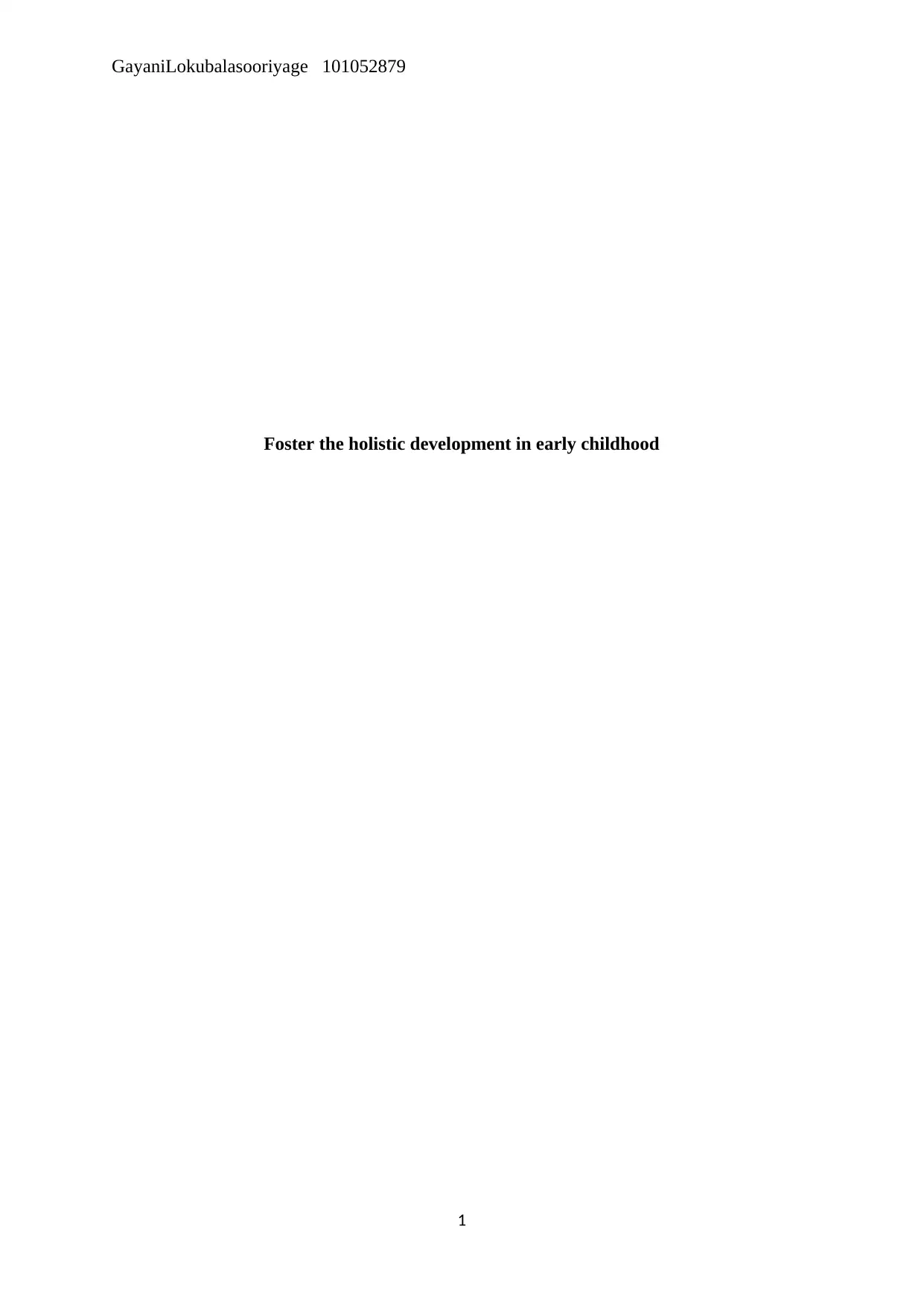
GayaniLokubalasooriyage 101052879
Foster the holistic development in early childhood
1
Foster the holistic development in early childhood
1
Paraphrase This Document
Need a fresh take? Get an instant paraphrase of this document with our AI Paraphraser
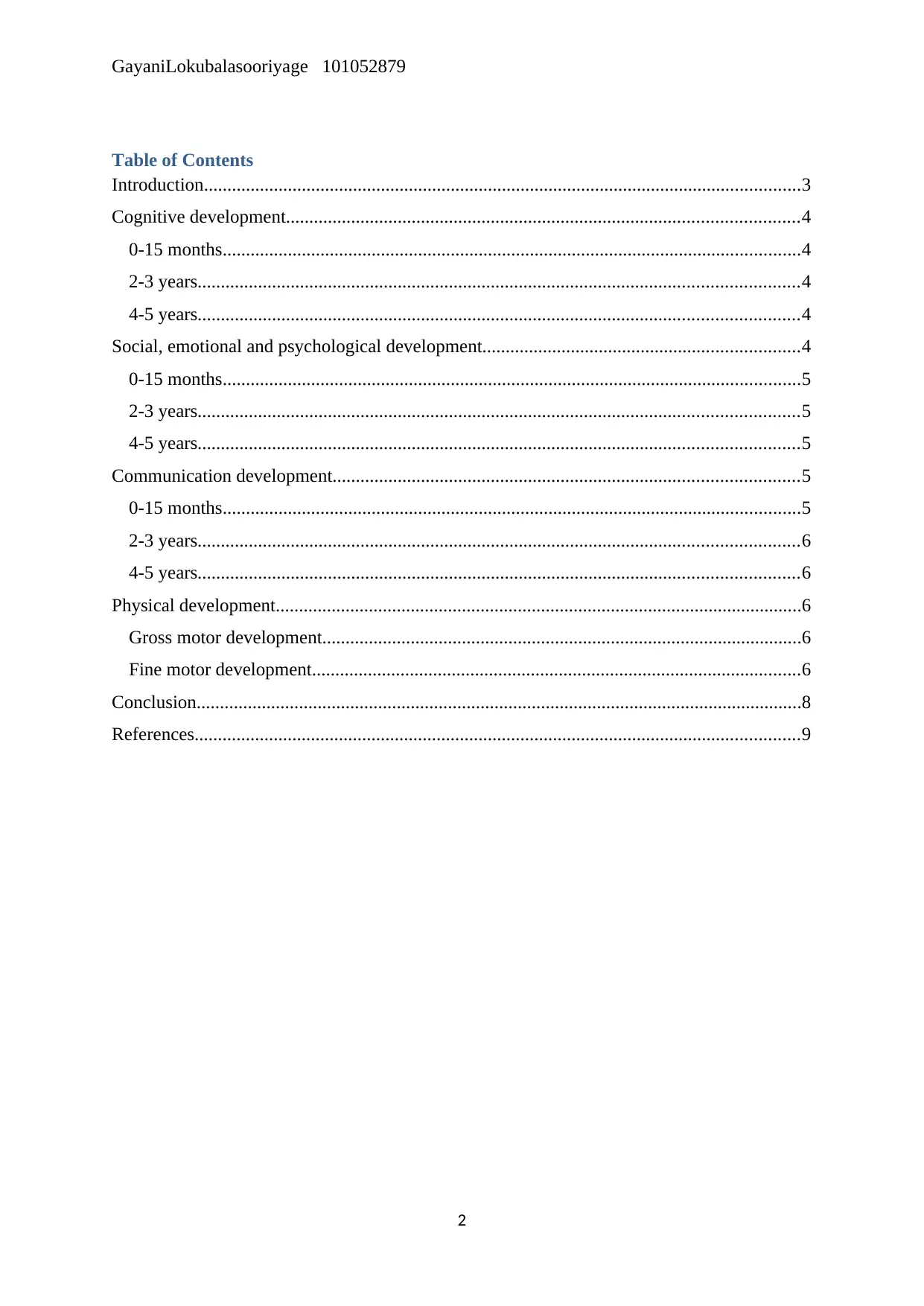
GayaniLokubalasooriyage 101052879
Table of Contents
Introduction................................................................................................................................3
Cognitive development..............................................................................................................4
0-15 months............................................................................................................................4
2-3 years.................................................................................................................................4
4-5 years.................................................................................................................................4
Social, emotional and psychological development....................................................................4
0-15 months............................................................................................................................5
2-3 years.................................................................................................................................5
4-5 years.................................................................................................................................5
Communication development....................................................................................................5
0-15 months............................................................................................................................5
2-3 years.................................................................................................................................6
4-5 years.................................................................................................................................6
Physical development.................................................................................................................6
Gross motor development.......................................................................................................6
Fine motor development.........................................................................................................6
Conclusion..................................................................................................................................8
References..................................................................................................................................9
2
Table of Contents
Introduction................................................................................................................................3
Cognitive development..............................................................................................................4
0-15 months............................................................................................................................4
2-3 years.................................................................................................................................4
4-5 years.................................................................................................................................4
Social, emotional and psychological development....................................................................4
0-15 months............................................................................................................................5
2-3 years.................................................................................................................................5
4-5 years.................................................................................................................................5
Communication development....................................................................................................5
0-15 months............................................................................................................................5
2-3 years.................................................................................................................................6
4-5 years.................................................................................................................................6
Physical development.................................................................................................................6
Gross motor development.......................................................................................................6
Fine motor development.........................................................................................................6
Conclusion..................................................................................................................................8
References..................................................................................................................................9
2

GayaniLokubalasooriyage 101052879
Introduction
This report is based on the holistic development during childhood. This report is divided into
four major developments for the well-being of childhood i.e. cognitive development, social
and emotional development, communication development and physical development. These
four developments are classified into three stages. The first stage is related to the age from 0-
15 months then the second stage is from 2-3 years and the third stage is from 4-5 years. This
report provides a detailed description of developments in child during the period of 0-5 years
of age.
3
Introduction
This report is based on the holistic development during childhood. This report is divided into
four major developments for the well-being of childhood i.e. cognitive development, social
and emotional development, communication development and physical development. These
four developments are classified into three stages. The first stage is related to the age from 0-
15 months then the second stage is from 2-3 years and the third stage is from 4-5 years. This
report provides a detailed description of developments in child during the period of 0-5 years
of age.
3
⊘ This is a preview!⊘
Do you want full access?
Subscribe today to unlock all pages.

Trusted by 1+ million students worldwide
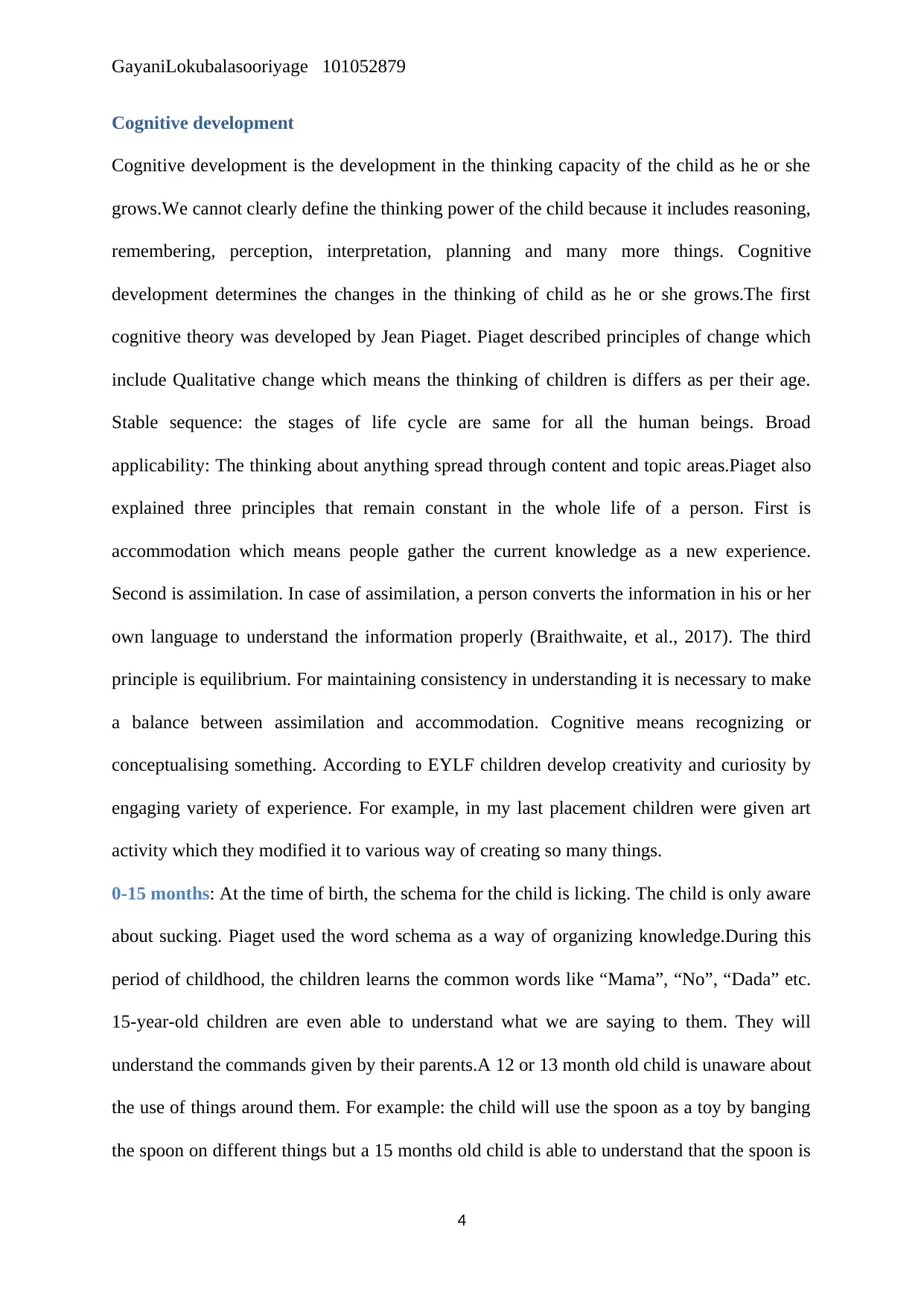
GayaniLokubalasooriyage 101052879
Cognitive development
Cognitive development is the development in the thinking capacity of the child as he or she
grows.We cannot clearly define the thinking power of the child because it includes reasoning,
remembering, perception, interpretation, planning and many more things. Cognitive
development determines the changes in the thinking of child as he or she grows.The first
cognitive theory was developed by Jean Piaget. Piaget described principles of change which
include Qualitative change which means the thinking of children is differs as per their age.
Stable sequence: the stages of life cycle are same for all the human beings. Broad
applicability: The thinking about anything spread through content and topic areas.Piaget also
explained three principles that remain constant in the whole life of a person. First is
accommodation which means people gather the current knowledge as a new experience.
Second is assimilation. In case of assimilation, a person converts the information in his or her
own language to understand the information properly (Braithwaite, et al., 2017). The third
principle is equilibrium. For maintaining consistency in understanding it is necessary to make
a balance between assimilation and accommodation. Cognitive means recognizing or
conceptualising something. According to EYLF children develop creativity and curiosity by
engaging variety of experience. For example, in my last placement children were given art
activity which they modified it to various way of creating so many things.
0-15 months: At the time of birth, the schema for the child is licking. The child is only aware
about sucking. Piaget used the word schema as a way of organizing knowledge.During this
period of childhood, the children learns the common words like “Mama”, “No”, “Dada” etc.
15-year-old children are even able to understand what we are saying to them. They will
understand the commands given by their parents.A 12 or 13 month old child is unaware about
the use of things around them. For example: the child will use the spoon as a toy by banging
the spoon on different things but a 15 months old child is able to understand that the spoon is
4
Cognitive development
Cognitive development is the development in the thinking capacity of the child as he or she
grows.We cannot clearly define the thinking power of the child because it includes reasoning,
remembering, perception, interpretation, planning and many more things. Cognitive
development determines the changes in the thinking of child as he or she grows.The first
cognitive theory was developed by Jean Piaget. Piaget described principles of change which
include Qualitative change which means the thinking of children is differs as per their age.
Stable sequence: the stages of life cycle are same for all the human beings. Broad
applicability: The thinking about anything spread through content and topic areas.Piaget also
explained three principles that remain constant in the whole life of a person. First is
accommodation which means people gather the current knowledge as a new experience.
Second is assimilation. In case of assimilation, a person converts the information in his or her
own language to understand the information properly (Braithwaite, et al., 2017). The third
principle is equilibrium. For maintaining consistency in understanding it is necessary to make
a balance between assimilation and accommodation. Cognitive means recognizing or
conceptualising something. According to EYLF children develop creativity and curiosity by
engaging variety of experience. For example, in my last placement children were given art
activity which they modified it to various way of creating so many things.
0-15 months: At the time of birth, the schema for the child is licking. The child is only aware
about sucking. Piaget used the word schema as a way of organizing knowledge.During this
period of childhood, the children learns the common words like “Mama”, “No”, “Dada” etc.
15-year-old children are even able to understand what we are saying to them. They will
understand the commands given by their parents.A 12 or 13 month old child is unaware about
the use of things around them. For example: the child will use the spoon as a toy by banging
the spoon on different things but a 15 months old child is able to understand that the spoon is
4
Paraphrase This Document
Need a fresh take? Get an instant paraphrase of this document with our AI Paraphraser

GayaniLokubalasooriyage 101052879
only used for eating (Rudd, et al., 2016). In this theory, there were actually four child
development stages and sensory-motor stage was the first in the list. In this stage, the child
tries to learn and understand the environment basically by making use of his/her sensory and
motor abilities (Schneider et al, 2014). A child of this age, technically has a lot to learn about
but has little time to do so. Therefore, by using their sensory abilities like touch, listening,
sucking, watching, grasping become a part of their learning tools which (Di Paolo et al,
2014). This means that the child’s understanding of the world rests entirely on his ability to
respond to his/her sensory stimuli ad motor reactions and movements (Bjorklund, 2013).
However, for children in this age, they are in no position to know and determine exactly what
to feel, which makes this stage less useful for children of 1-15 months.
Another theory is the Lev Vygotsky theory. In his theory, Vygotsky states that child
development, environmental understanding and growth is determined by the child’s personal
knowledge on its surrounding social environment (Frye, 2014). This theory also states that a
child can best understand the social environment by being more knowledgeable especially in
its own language, technical and cultural environmental aspects. Therefore, the development
of a child between 0-15 months can only be determined by knowing the child’s knowledge of
its language and understanding its own knowledge on social community.
2-3 years: This is the stage of cognitive development when the child starts
rememberingdifferent things. As per the cognitive milestones, during this age, the child starts
recognising the likes and dislikes of parents and other family members.The period from 2-3
years of age is the stage of accommodation. In this stage, the child only knows a few things
and will relate all the other things with it. For example: if a child knows about cow then he or
she will recognize the buffalo or the bull as cow. Lev Vygotsky and Jerome Bruner are the
two theorists that researched on child cognitive development apart from Piaget. These two
theorists determined that cognitive development of a child is determined by the child’s
5
only used for eating (Rudd, et al., 2016). In this theory, there were actually four child
development stages and sensory-motor stage was the first in the list. In this stage, the child
tries to learn and understand the environment basically by making use of his/her sensory and
motor abilities (Schneider et al, 2014). A child of this age, technically has a lot to learn about
but has little time to do so. Therefore, by using their sensory abilities like touch, listening,
sucking, watching, grasping become a part of their learning tools which (Di Paolo et al,
2014). This means that the child’s understanding of the world rests entirely on his ability to
respond to his/her sensory stimuli ad motor reactions and movements (Bjorklund, 2013).
However, for children in this age, they are in no position to know and determine exactly what
to feel, which makes this stage less useful for children of 1-15 months.
Another theory is the Lev Vygotsky theory. In his theory, Vygotsky states that child
development, environmental understanding and growth is determined by the child’s personal
knowledge on its surrounding social environment (Frye, 2014). This theory also states that a
child can best understand the social environment by being more knowledgeable especially in
its own language, technical and cultural environmental aspects. Therefore, the development
of a child between 0-15 months can only be determined by knowing the child’s knowledge of
its language and understanding its own knowledge on social community.
2-3 years: This is the stage of cognitive development when the child starts
rememberingdifferent things. As per the cognitive milestones, during this age, the child starts
recognising the likes and dislikes of parents and other family members.The period from 2-3
years of age is the stage of accommodation. In this stage, the child only knows a few things
and will relate all the other things with it. For example: if a child knows about cow then he or
she will recognize the buffalo or the bull as cow. Lev Vygotsky and Jerome Bruner are the
two theorists that researched on child cognitive development apart from Piaget. These two
theorists determined that cognitive development of a child is determined by the child’s
5
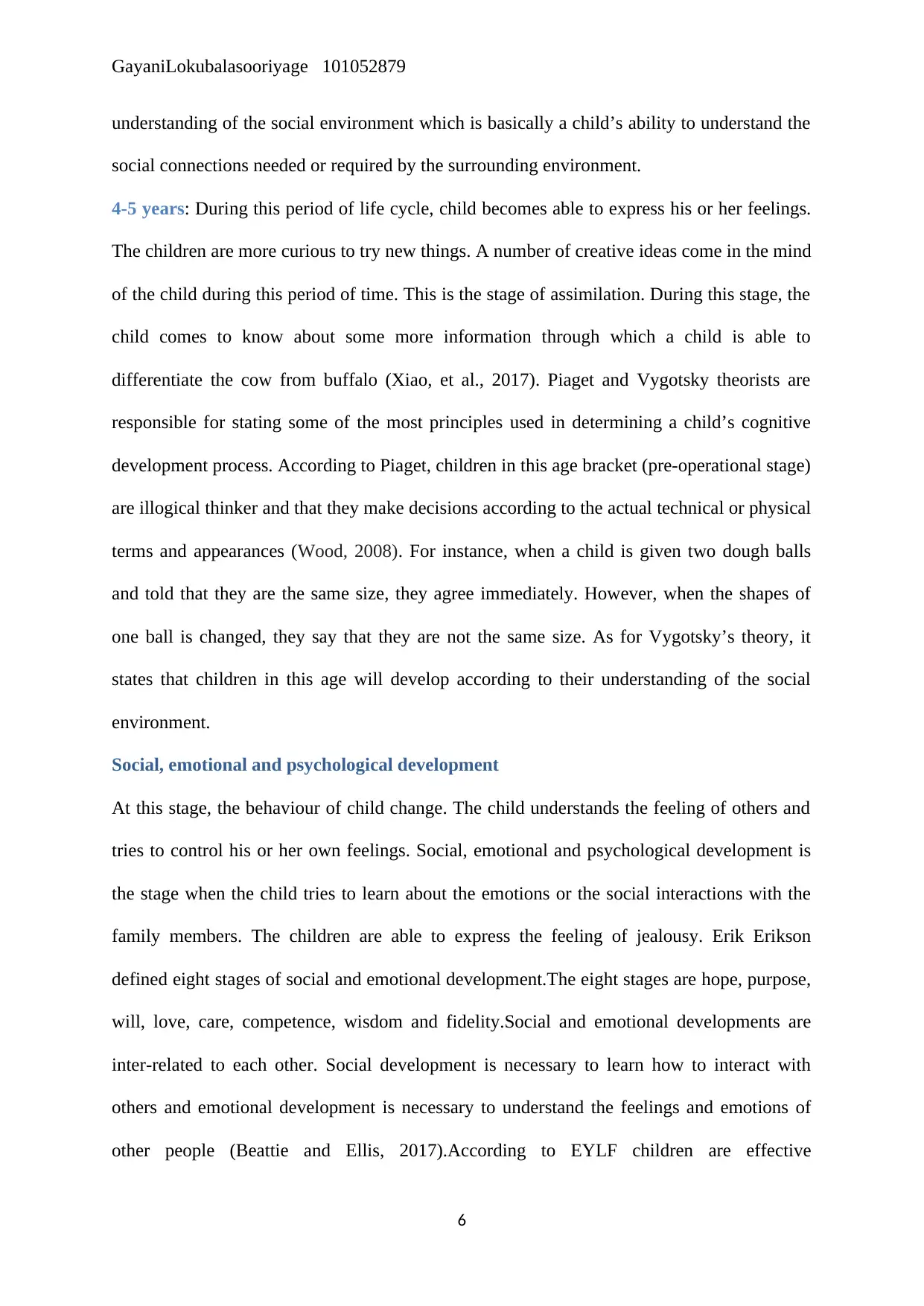
GayaniLokubalasooriyage 101052879
understanding of the social environment which is basically a child’s ability to understand the
social connections needed or required by the surrounding environment.
4-5 years: During this period of life cycle, child becomes able to express his or her feelings.
The children are more curious to try new things. A number of creative ideas come in the mind
of the child during this period of time. This is the stage of assimilation. During this stage, the
child comes to know about some more information through which a child is able to
differentiate the cow from buffalo (Xiao, et al., 2017). Piaget and Vygotsky theorists are
responsible for stating some of the most principles used in determining a child’s cognitive
development process. According to Piaget, children in this age bracket (pre-operational stage)
are illogical thinker and that they make decisions according to the actual technical or physical
terms and appearances (Wood, 2008). For instance, when a child is given two dough balls
and told that they are the same size, they agree immediately. However, when the shapes of
one ball is changed, they say that they are not the same size. As for Vygotsky’s theory, it
states that children in this age will develop according to their understanding of the social
environment.
Social, emotional and psychological development
At this stage, the behaviour of child change. The child understands the feeling of others and
tries to control his or her own feelings. Social, emotional and psychological development is
the stage when the child tries to learn about the emotions or the social interactions with the
family members. The children are able to express the feeling of jealousy. Erik Erikson
defined eight stages of social and emotional development.The eight stages are hope, purpose,
will, love, care, competence, wisdom and fidelity.Social and emotional developments are
inter-related to each other. Social development is necessary to learn how to interact with
others and emotional development is necessary to understand the feelings and emotions of
other people (Beattie and Ellis, 2017).According to EYLF children are effective
6
understanding of the social environment which is basically a child’s ability to understand the
social connections needed or required by the surrounding environment.
4-5 years: During this period of life cycle, child becomes able to express his or her feelings.
The children are more curious to try new things. A number of creative ideas come in the mind
of the child during this period of time. This is the stage of assimilation. During this stage, the
child comes to know about some more information through which a child is able to
differentiate the cow from buffalo (Xiao, et al., 2017). Piaget and Vygotsky theorists are
responsible for stating some of the most principles used in determining a child’s cognitive
development process. According to Piaget, children in this age bracket (pre-operational stage)
are illogical thinker and that they make decisions according to the actual technical or physical
terms and appearances (Wood, 2008). For instance, when a child is given two dough balls
and told that they are the same size, they agree immediately. However, when the shapes of
one ball is changed, they say that they are not the same size. As for Vygotsky’s theory, it
states that children in this age will develop according to their understanding of the social
environment.
Social, emotional and psychological development
At this stage, the behaviour of child change. The child understands the feeling of others and
tries to control his or her own feelings. Social, emotional and psychological development is
the stage when the child tries to learn about the emotions or the social interactions with the
family members. The children are able to express the feeling of jealousy. Erik Erikson
defined eight stages of social and emotional development.The eight stages are hope, purpose,
will, love, care, competence, wisdom and fidelity.Social and emotional developments are
inter-related to each other. Social development is necessary to learn how to interact with
others and emotional development is necessary to understand the feelings and emotions of
other people (Beattie and Ellis, 2017).According to EYLF children are effective
6
⊘ This is a preview!⊘
Do you want full access?
Subscribe today to unlock all pages.

Trusted by 1+ million students worldwide
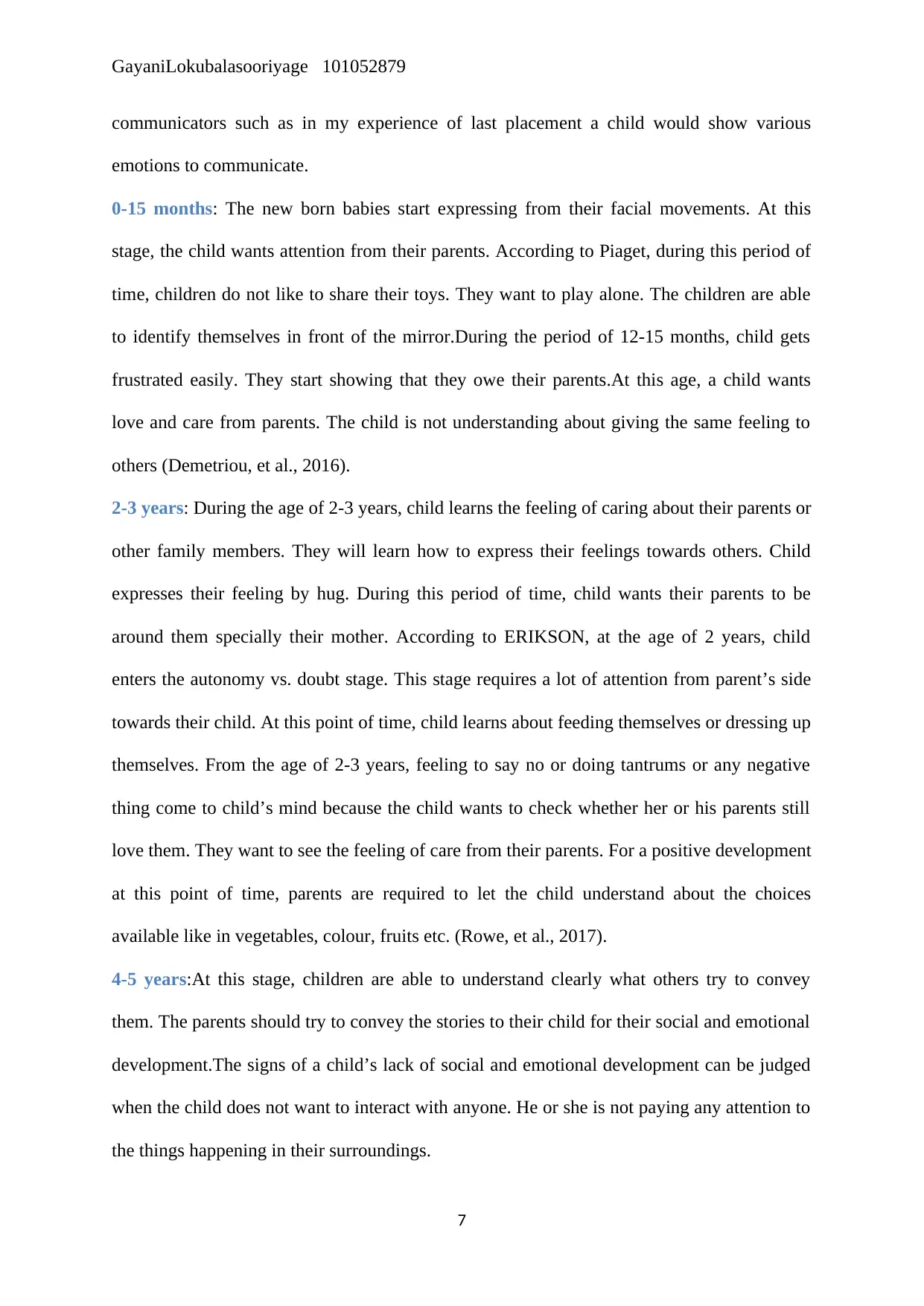
GayaniLokubalasooriyage 101052879
communicators such as in my experience of last placement a child would show various
emotions to communicate.
0-15 months: The new born babies start expressing from their facial movements. At this
stage, the child wants attention from their parents. According to Piaget, during this period of
time, children do not like to share their toys. They want to play alone. The children are able
to identify themselves in front of the mirror.During the period of 12-15 months, child gets
frustrated easily. They start showing that they owe their parents.At this age, a child wants
love and care from parents. The child is not understanding about giving the same feeling to
others (Demetriou, et al., 2016).
2-3 years: During the age of 2-3 years, child learns the feeling of caring about their parents or
other family members. They will learn how to express their feelings towards others. Child
expresses their feeling by hug. During this period of time, child wants their parents to be
around them specially their mother. According to ERIKSON, at the age of 2 years, child
enters the autonomy vs. doubt stage. This stage requires a lot of attention from parent’s side
towards their child. At this point of time, child learns about feeding themselves or dressing up
themselves. From the age of 2-3 years, feeling to say no or doing tantrums or any negative
thing come to child’s mind because the child wants to check whether her or his parents still
love them. They want to see the feeling of care from their parents. For a positive development
at this point of time, parents are required to let the child understand about the choices
available like in vegetables, colour, fruits etc. (Rowe, et al., 2017).
4-5 years:At this stage, children are able to understand clearly what others try to convey
them. The parents should try to convey the stories to their child for their social and emotional
development.The signs of a child’s lack of social and emotional development can be judged
when the child does not want to interact with anyone. He or she is not paying any attention to
the things happening in their surroundings.
7
communicators such as in my experience of last placement a child would show various
emotions to communicate.
0-15 months: The new born babies start expressing from their facial movements. At this
stage, the child wants attention from their parents. According to Piaget, during this period of
time, children do not like to share their toys. They want to play alone. The children are able
to identify themselves in front of the mirror.During the period of 12-15 months, child gets
frustrated easily. They start showing that they owe their parents.At this age, a child wants
love and care from parents. The child is not understanding about giving the same feeling to
others (Demetriou, et al., 2016).
2-3 years: During the age of 2-3 years, child learns the feeling of caring about their parents or
other family members. They will learn how to express their feelings towards others. Child
expresses their feeling by hug. During this period of time, child wants their parents to be
around them specially their mother. According to ERIKSON, at the age of 2 years, child
enters the autonomy vs. doubt stage. This stage requires a lot of attention from parent’s side
towards their child. At this point of time, child learns about feeding themselves or dressing up
themselves. From the age of 2-3 years, feeling to say no or doing tantrums or any negative
thing come to child’s mind because the child wants to check whether her or his parents still
love them. They want to see the feeling of care from their parents. For a positive development
at this point of time, parents are required to let the child understand about the choices
available like in vegetables, colour, fruits etc. (Rowe, et al., 2017).
4-5 years:At this stage, children are able to understand clearly what others try to convey
them. The parents should try to convey the stories to their child for their social and emotional
development.The signs of a child’s lack of social and emotional development can be judged
when the child does not want to interact with anyone. He or she is not paying any attention to
the things happening in their surroundings.
7
Paraphrase This Document
Need a fresh take? Get an instant paraphrase of this document with our AI Paraphraser

GayaniLokubalasooriyage 101052879
Communication development
Communication is the most crucial part of human being’s life. The child is able to convey his
feelings to others by communicating with others. For being able to communicate, the one
thing which is necessary is listening carefully. Communication amplifies the
voice.Vygotsky's theory suggested that the communication of the child is dependent upon the
people around the child. The tone of talking of the child is mostly as per his or her parents or
partly according to his or her friends. The communication of the child’s affected by the
conversation of the child with the adults (Camras and Halberstadt, 2017). In EYLF
mentioned as children are curious being who communicate various ways such as sign
language, facial expressions etc. As an example in my last placement children shown various
facial expression like when they dis like something they have a moody and sad face.
0-15 months: At this stage, the child learns only a few words like ‘Mama’, ‘Papa’ etc. The
child is not able to communicate properly but he or she is listening carefully all the things
that their parents are communicating with them. According to Vygotsky, during this age, a
child tries to communicate in his or her own language which is difficult to be understood.
During 12-15 months age of your child, parents need to take due care while speaking because
the child is copying every word parents speak in front of them.The child is able to speak
single words. He or she cannot communicate in whole sentence. Between the ages of 1-12
months, the children are only able to recognise your voice or they will start starring you when
you speak (Wismer Fries and Pollak, 2017).During this age, child use more non-verbal
communication as compared to verbal communication. There are other theorists who have
studied the communication development of children in this age group, i.e. BF Skinner, John
Watson and Albert Bandura. They are categorised in the behaviourists’ theorists’ category
whereby they focus on understanding a child’s behavioural change and development which is
basically communication technique for children. These theorists stated that a child’s positive
8
Communication development
Communication is the most crucial part of human being’s life. The child is able to convey his
feelings to others by communicating with others. For being able to communicate, the one
thing which is necessary is listening carefully. Communication amplifies the
voice.Vygotsky's theory suggested that the communication of the child is dependent upon the
people around the child. The tone of talking of the child is mostly as per his or her parents or
partly according to his or her friends. The communication of the child’s affected by the
conversation of the child with the adults (Camras and Halberstadt, 2017). In EYLF
mentioned as children are curious being who communicate various ways such as sign
language, facial expressions etc. As an example in my last placement children shown various
facial expression like when they dis like something they have a moody and sad face.
0-15 months: At this stage, the child learns only a few words like ‘Mama’, ‘Papa’ etc. The
child is not able to communicate properly but he or she is listening carefully all the things
that their parents are communicating with them. According to Vygotsky, during this age, a
child tries to communicate in his or her own language which is difficult to be understood.
During 12-15 months age of your child, parents need to take due care while speaking because
the child is copying every word parents speak in front of them.The child is able to speak
single words. He or she cannot communicate in whole sentence. Between the ages of 1-12
months, the children are only able to recognise your voice or they will start starring you when
you speak (Wismer Fries and Pollak, 2017).During this age, child use more non-verbal
communication as compared to verbal communication. There are other theorists who have
studied the communication development of children in this age group, i.e. BF Skinner, John
Watson and Albert Bandura. They are categorised in the behaviourists’ theorists’ category
whereby they focus on understanding a child’s behavioural change and development which is
basically communication technique for children. These theorists stated that a child’s positive
8
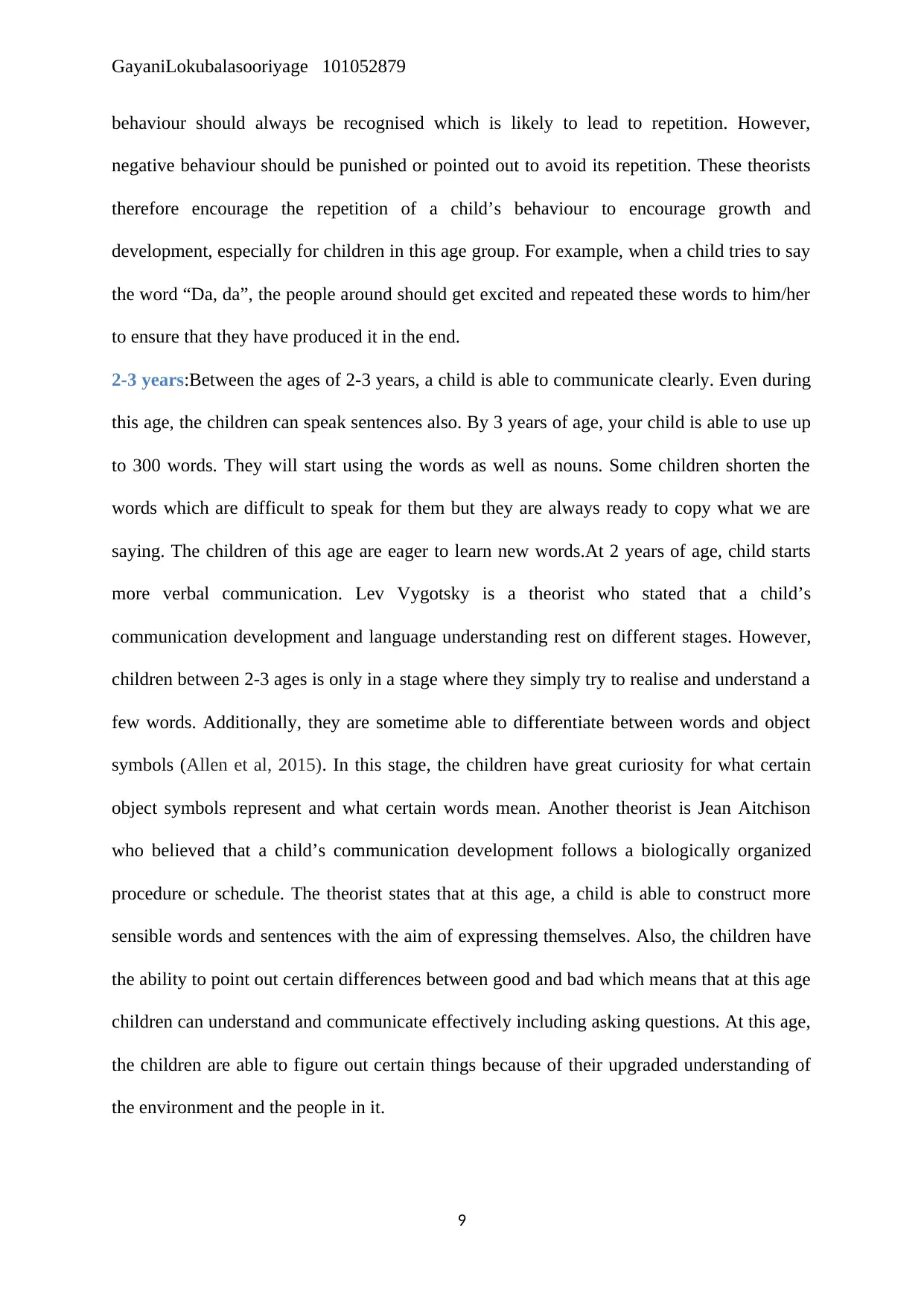
GayaniLokubalasooriyage 101052879
behaviour should always be recognised which is likely to lead to repetition. However,
negative behaviour should be punished or pointed out to avoid its repetition. These theorists
therefore encourage the repetition of a child’s behaviour to encourage growth and
development, especially for children in this age group. For example, when a child tries to say
the word “Da, da”, the people around should get excited and repeated these words to him/her
to ensure that they have produced it in the end.
2-3 years:Between the ages of 2-3 years, a child is able to communicate clearly. Even during
this age, the children can speak sentences also. By 3 years of age, your child is able to use up
to 300 words. They will start using the words as well as nouns. Some children shorten the
words which are difficult to speak for them but they are always ready to copy what we are
saying. The children of this age are eager to learn new words.At 2 years of age, child starts
more verbal communication. Lev Vygotsky is a theorist who stated that a child’s
communication development and language understanding rest on different stages. However,
children between 2-3 ages is only in a stage where they simply try to realise and understand a
few words. Additionally, they are sometime able to differentiate between words and object
symbols (Allen et al, 2015). In this stage, the children have great curiosity for what certain
object symbols represent and what certain words mean. Another theorist is Jean Aitchison
who believed that a child’s communication development follows a biologically organized
procedure or schedule. The theorist states that at this age, a child is able to construct more
sensible words and sentences with the aim of expressing themselves. Also, the children have
the ability to point out certain differences between good and bad which means that at this age
children can understand and communicate effectively including asking questions. At this age,
the children are able to figure out certain things because of their upgraded understanding of
the environment and the people in it.
9
behaviour should always be recognised which is likely to lead to repetition. However,
negative behaviour should be punished or pointed out to avoid its repetition. These theorists
therefore encourage the repetition of a child’s behaviour to encourage growth and
development, especially for children in this age group. For example, when a child tries to say
the word “Da, da”, the people around should get excited and repeated these words to him/her
to ensure that they have produced it in the end.
2-3 years:Between the ages of 2-3 years, a child is able to communicate clearly. Even during
this age, the children can speak sentences also. By 3 years of age, your child is able to use up
to 300 words. They will start using the words as well as nouns. Some children shorten the
words which are difficult to speak for them but they are always ready to copy what we are
saying. The children of this age are eager to learn new words.At 2 years of age, child starts
more verbal communication. Lev Vygotsky is a theorist who stated that a child’s
communication development and language understanding rest on different stages. However,
children between 2-3 ages is only in a stage where they simply try to realise and understand a
few words. Additionally, they are sometime able to differentiate between words and object
symbols (Allen et al, 2015). In this stage, the children have great curiosity for what certain
object symbols represent and what certain words mean. Another theorist is Jean Aitchison
who believed that a child’s communication development follows a biologically organized
procedure or schedule. The theorist states that at this age, a child is able to construct more
sensible words and sentences with the aim of expressing themselves. Also, the children have
the ability to point out certain differences between good and bad which means that at this age
children can understand and communicate effectively including asking questions. At this age,
the children are able to figure out certain things because of their upgraded understanding of
the environment and the people in it.
9
⊘ This is a preview!⊘
Do you want full access?
Subscribe today to unlock all pages.

Trusted by 1+ million students worldwide

GayaniLokubalasooriyage 101052879
4-5 years: At this stage, child is able to understand the complex words like might, above, in
between etc. The children are able to pronounce the words properly. During this stage, their
ability to listen also increases.The child is able to speak in sentence of up to nine
words.Understand spoken instructions without stopping what they are doing to look at the
speaker. During this age, your child will start to understand the words describing and
sequences such as “first we are going for the movie, next we will go for dinner”.
Additionally, they are able to choose their own play mates and friends, take turns in
conversations of long sentences, try to use the well-formed sentences still they are having
some difficulties in using proper grammar. Theorists like Lev Vygotsky came up with a
theory to help researchers understand communication development of a child in this age
group. The theorists lists these children to be in the stage of egocentric and private speech. In
this stage the children seem to understand themselves better and especially what they are
saying. The children seem to talk by themselves and in loud voices with the aim of
expressing themselves and thought. The theorists states that the children are capable of
solving problems and making simple decisions on their own at this age (Allen et al, 2015).
Another theorist, Noam Chomsky, states that every child is originally born with a certain
level of ability to understand and interpret language in order to communicate. The theorist
states that every child has a “language acquisition device (LAD)” that helps then encode and
understand a certain language. In this age, the children are able to point out errors that are
made in a conversation whether grammatical or ungrammatical. The theory states that no
matter what, a child of this age is capable of understanding and communicating effectively
with people and with each other through fluent native language.
Physical development
Physical development includes how the child uses his or her body in daily activities.Physical
development is an important part of life cycle.There are two terms which are included in
10
4-5 years: At this stage, child is able to understand the complex words like might, above, in
between etc. The children are able to pronounce the words properly. During this stage, their
ability to listen also increases.The child is able to speak in sentence of up to nine
words.Understand spoken instructions without stopping what they are doing to look at the
speaker. During this age, your child will start to understand the words describing and
sequences such as “first we are going for the movie, next we will go for dinner”.
Additionally, they are able to choose their own play mates and friends, take turns in
conversations of long sentences, try to use the well-formed sentences still they are having
some difficulties in using proper grammar. Theorists like Lev Vygotsky came up with a
theory to help researchers understand communication development of a child in this age
group. The theorists lists these children to be in the stage of egocentric and private speech. In
this stage the children seem to understand themselves better and especially what they are
saying. The children seem to talk by themselves and in loud voices with the aim of
expressing themselves and thought. The theorists states that the children are capable of
solving problems and making simple decisions on their own at this age (Allen et al, 2015).
Another theorist, Noam Chomsky, states that every child is originally born with a certain
level of ability to understand and interpret language in order to communicate. The theorist
states that every child has a “language acquisition device (LAD)” that helps then encode and
understand a certain language. In this age, the children are able to point out errors that are
made in a conversation whether grammatical or ungrammatical. The theory states that no
matter what, a child of this age is capable of understanding and communicating effectively
with people and with each other through fluent native language.
Physical development
Physical development includes how the child uses his or her body in daily activities.Physical
development is an important part of life cycle.There are two terms which are included in
10
Paraphrase This Document
Need a fresh take? Get an instant paraphrase of this document with our AI Paraphraser
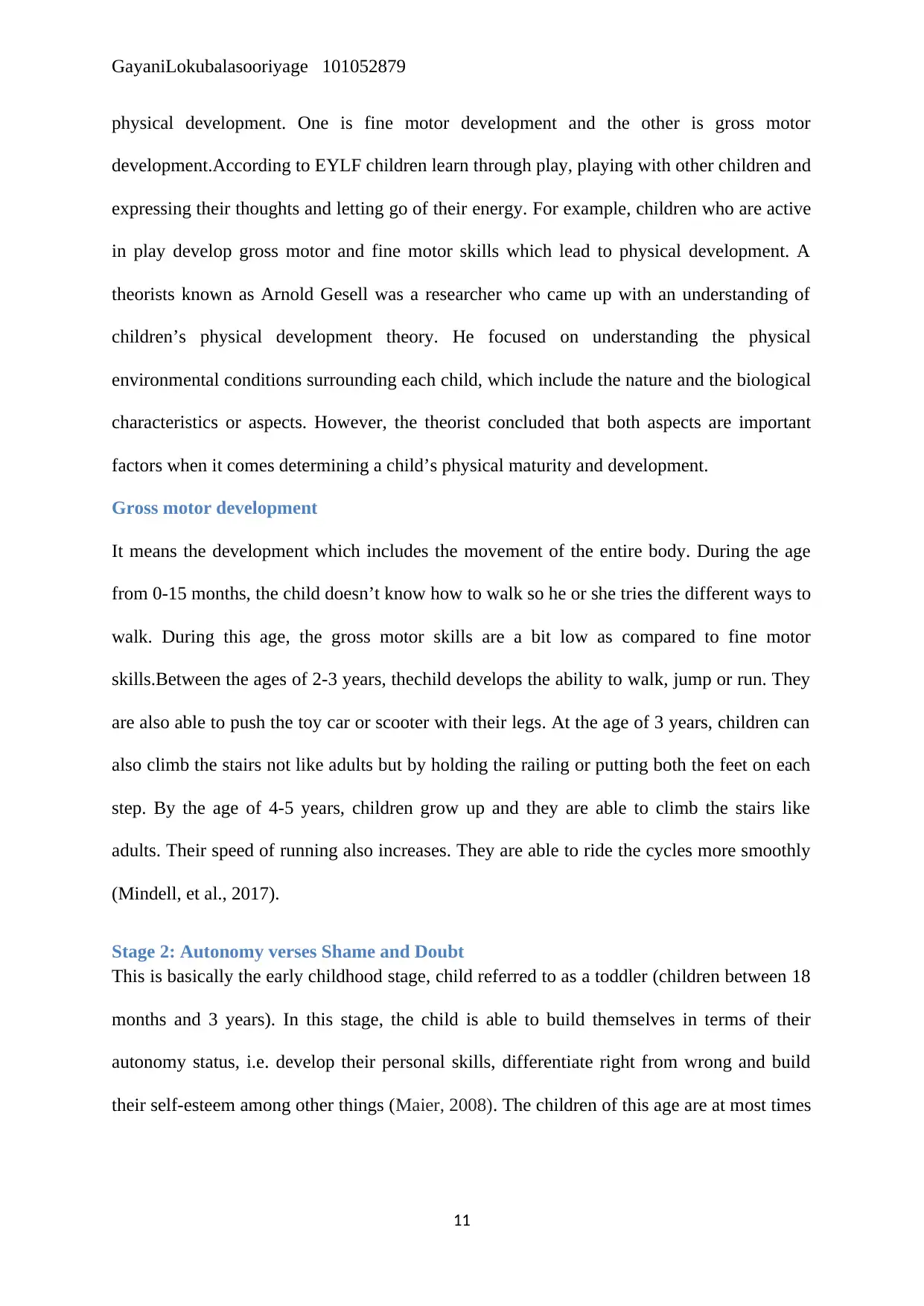
GayaniLokubalasooriyage 101052879
physical development. One is fine motor development and the other is gross motor
development.According to EYLF children learn through play, playing with other children and
expressing their thoughts and letting go of their energy. For example, children who are active
in play develop gross motor and fine motor skills which lead to physical development. A
theorists known as Arnold Gesell was a researcher who came up with an understanding of
children’s physical development theory. He focused on understanding the physical
environmental conditions surrounding each child, which include the nature and the biological
characteristics or aspects. However, the theorist concluded that both aspects are important
factors when it comes determining a child’s physical maturity and development.
Gross motor development
It means the development which includes the movement of the entire body. During the age
from 0-15 months, the child doesn’t know how to walk so he or she tries the different ways to
walk. During this age, the gross motor skills are a bit low as compared to fine motor
skills.Between the ages of 2-3 years, thechild develops the ability to walk, jump or run. They
are also able to push the toy car or scooter with their legs. At the age of 3 years, children can
also climb the stairs not like adults but by holding the railing or putting both the feet on each
step. By the age of 4-5 years, children grow up and they are able to climb the stairs like
adults. Their speed of running also increases. They are able to ride the cycles more smoothly
(Mindell, et al., 2017).
Stage 2: Autonomy verses Shame and Doubt
This is basically the early childhood stage, child referred to as a toddler (children between 18
months and 3 years). In this stage, the child is able to build themselves in terms of their
autonomy status, i.e. develop their personal skills, differentiate right from wrong and build
their self-esteem among other things (Maier, 2008). The children of this age are at most times
11
physical development. One is fine motor development and the other is gross motor
development.According to EYLF children learn through play, playing with other children and
expressing their thoughts and letting go of their energy. For example, children who are active
in play develop gross motor and fine motor skills which lead to physical development. A
theorists known as Arnold Gesell was a researcher who came up with an understanding of
children’s physical development theory. He focused on understanding the physical
environmental conditions surrounding each child, which include the nature and the biological
characteristics or aspects. However, the theorist concluded that both aspects are important
factors when it comes determining a child’s physical maturity and development.
Gross motor development
It means the development which includes the movement of the entire body. During the age
from 0-15 months, the child doesn’t know how to walk so he or she tries the different ways to
walk. During this age, the gross motor skills are a bit low as compared to fine motor
skills.Between the ages of 2-3 years, thechild develops the ability to walk, jump or run. They
are also able to push the toy car or scooter with their legs. At the age of 3 years, children can
also climb the stairs not like adults but by holding the railing or putting both the feet on each
step. By the age of 4-5 years, children grow up and they are able to climb the stairs like
adults. Their speed of running also increases. They are able to ride the cycles more smoothly
(Mindell, et al., 2017).
Stage 2: Autonomy verses Shame and Doubt
This is basically the early childhood stage, child referred to as a toddler (children between 18
months and 3 years). In this stage, the child is able to build themselves in terms of their
autonomy status, i.e. develop their personal skills, differentiate right from wrong and build
their self-esteem among other things (Maier, 2008). The children of this age are at most times
11
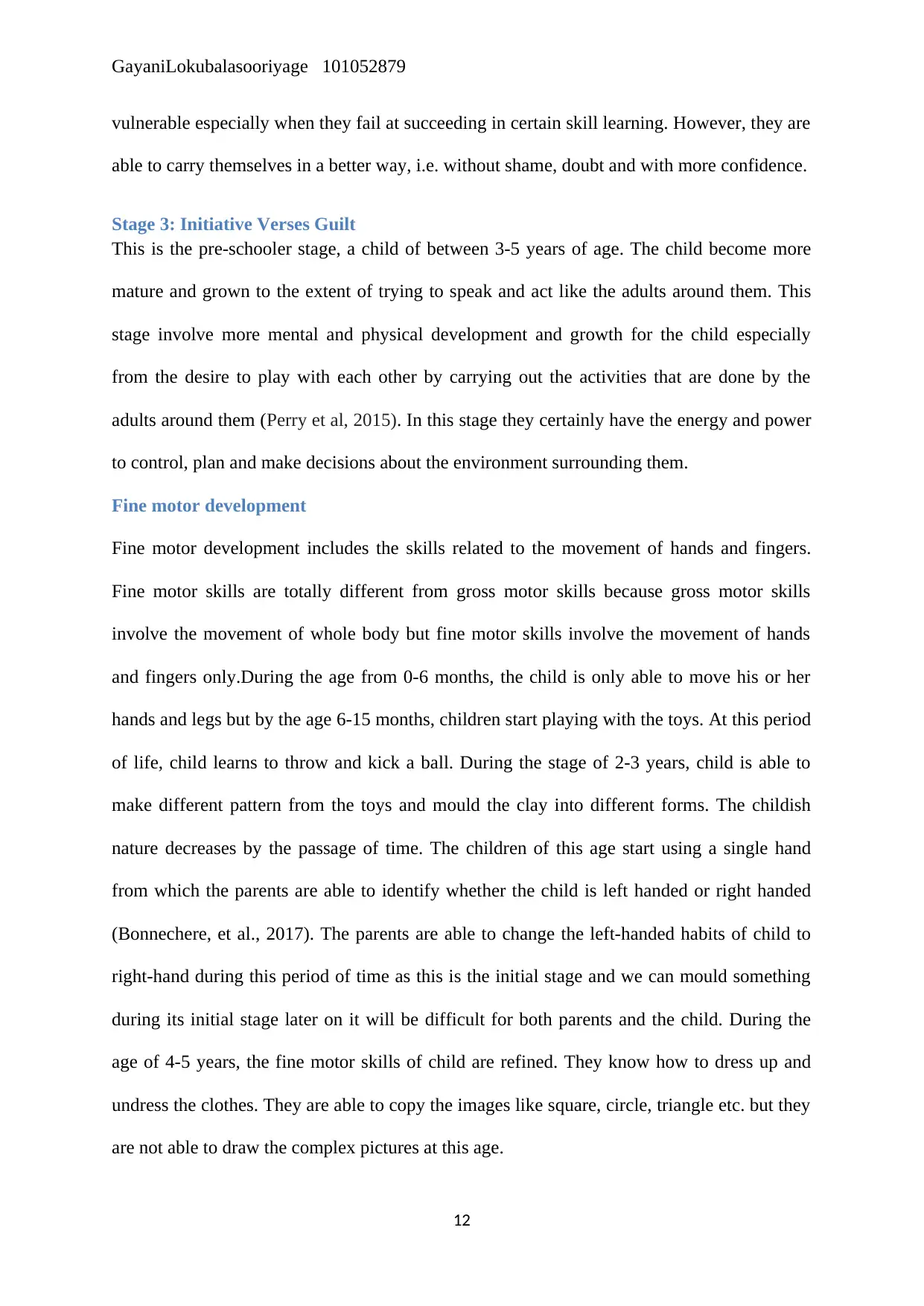
GayaniLokubalasooriyage 101052879
vulnerable especially when they fail at succeeding in certain skill learning. However, they are
able to carry themselves in a better way, i.e. without shame, doubt and with more confidence.
Stage 3: Initiative Verses Guilt
This is the pre-schooler stage, a child of between 3-5 years of age. The child become more
mature and grown to the extent of trying to speak and act like the adults around them. This
stage involve more mental and physical development and growth for the child especially
from the desire to play with each other by carrying out the activities that are done by the
adults around them (Perry et al, 2015). In this stage they certainly have the energy and power
to control, plan and make decisions about the environment surrounding them.
Fine motor development
Fine motor development includes the skills related to the movement of hands and fingers.
Fine motor skills are totally different from gross motor skills because gross motor skills
involve the movement of whole body but fine motor skills involve the movement of hands
and fingers only.During the age from 0-6 months, the child is only able to move his or her
hands and legs but by the age 6-15 months, children start playing with the toys. At this period
of life, child learns to throw and kick a ball. During the stage of 2-3 years, child is able to
make different pattern from the toys and mould the clay into different forms. The childish
nature decreases by the passage of time. The children of this age start using a single hand
from which the parents are able to identify whether the child is left handed or right handed
(Bonnechere, et al., 2017). The parents are able to change the left-handed habits of child to
right-hand during this period of time as this is the initial stage and we can mould something
during its initial stage later on it will be difficult for both parents and the child. During the
age of 4-5 years, the fine motor skills of child are refined. They know how to dress up and
undress the clothes. They are able to copy the images like square, circle, triangle etc. but they
are not able to draw the complex pictures at this age.
12
vulnerable especially when they fail at succeeding in certain skill learning. However, they are
able to carry themselves in a better way, i.e. without shame, doubt and with more confidence.
Stage 3: Initiative Verses Guilt
This is the pre-schooler stage, a child of between 3-5 years of age. The child become more
mature and grown to the extent of trying to speak and act like the adults around them. This
stage involve more mental and physical development and growth for the child especially
from the desire to play with each other by carrying out the activities that are done by the
adults around them (Perry et al, 2015). In this stage they certainly have the energy and power
to control, plan and make decisions about the environment surrounding them.
Fine motor development
Fine motor development includes the skills related to the movement of hands and fingers.
Fine motor skills are totally different from gross motor skills because gross motor skills
involve the movement of whole body but fine motor skills involve the movement of hands
and fingers only.During the age from 0-6 months, the child is only able to move his or her
hands and legs but by the age 6-15 months, children start playing with the toys. At this period
of life, child learns to throw and kick a ball. During the stage of 2-3 years, child is able to
make different pattern from the toys and mould the clay into different forms. The childish
nature decreases by the passage of time. The children of this age start using a single hand
from which the parents are able to identify whether the child is left handed or right handed
(Bonnechere, et al., 2017). The parents are able to change the left-handed habits of child to
right-hand during this period of time as this is the initial stage and we can mould something
during its initial stage later on it will be difficult for both parents and the child. During the
age of 4-5 years, the fine motor skills of child are refined. They know how to dress up and
undress the clothes. They are able to copy the images like square, circle, triangle etc. but they
are not able to draw the complex pictures at this age.
12
⊘ This is a preview!⊘
Do you want full access?
Subscribe today to unlock all pages.

Trusted by 1+ million students worldwide
1 out of 16
Related Documents
Your All-in-One AI-Powered Toolkit for Academic Success.
+13062052269
info@desklib.com
Available 24*7 on WhatsApp / Email
![[object Object]](/_next/static/media/star-bottom.7253800d.svg)
Unlock your academic potential
Copyright © 2020–2025 A2Z Services. All Rights Reserved. Developed and managed by ZUCOL.





